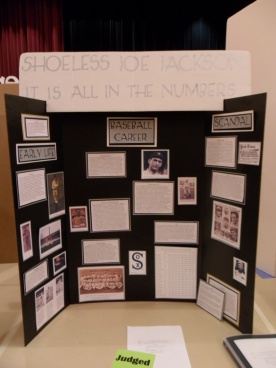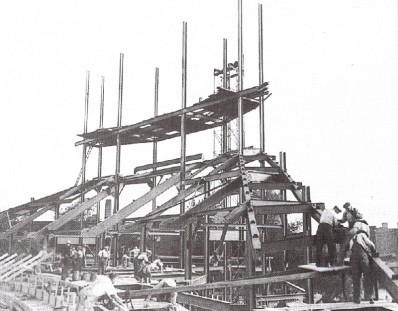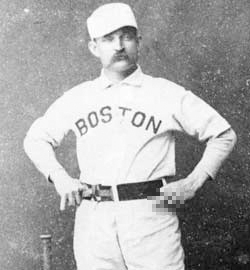Baseball and history tend to go together. This blog is no different. As a practicing teacher whose students participate in the Illinois Historic Preservation Agency’s Student Historian Program (aka History Fair) and National History Day, I steer some reluctant kids towards baseball topics. It has worked and has changed lives. One of my most successful students did three baseball exhibits, two research papers, and one hockey exhibit over six years in route to six superior ribbons at the state history fair. He is now a sophomore in the honors program at Northern Illinois University and his work as a junior in high school can be read here.  He spoke at a conference with me last fall and talked about how doing these projects made him a better student.
He spoke at a conference with me last fall and talked about how doing these projects made him a better student.
Choosing a baseball topic for a history fair project has many advantages. First, the use of newspapers and interviews as primary sources are great tools for any historian. Learning how to find information through these early accounts are exactly what historians do in researching any topic. Second, it teaches verb usage. Most of these accounts use verbs in the active tense. This creates a text that is more exciting, easy to read, and most importantly, makes the subject and writing come alive.
A third reason for using baseball as a history fair topic is that it teaches structure. Students learn how to organize information. They can organize their paper, board, website, or document chronologically, thematically, and statistically. With the plethora of sports statistic sites like Baseball Reference, Baseball Almanac, and Fan Graphs, it is easy for the student to acquire information and data to help prove their thesis. Whether it is numeric data, hitting charts, or hitting zones, the images can be to cover a year, career, and any significant data stream the user requires or inputs.
The fourth, and maybe the most important, reason for choosing a baseball related topic is that the player or event showcases a change in American society that is reflected on the diamond. From the use of defense and pitching with Tinkers to Evers to Chance to the cheating and gambling industry of the White Sox Scandal to the creation of the Negro Leagues by Rube Foster, the history of baseball in Illinois shows the history of change in Illinois. One of the key aspects of grading any history fair project is can the student(s) show how their topic changed history. A baseball topic clearly does that using evidence over time.
Fifth, and most importantly for the student, it is fun. I can’t begin to tell you how many times I saw a student get excited about learning history by doing their history fair project about a baseball topic. Once that happens, the student is hooked and puts all their efforts into creating a product of which they are proud.

As a teacher who is retiring in the next 5-8 years, when I look back at all the successful baseball projects my students created, I get a little misty because the topics were monumental events or personalities in the game. Students assembled projects on Mordecai Three Finger Brown, Albert Spalding, Tinkers to Evers to Chance, the 1906 World Series, Rube Foster, Baseball in Rockford in the 1800s, Shoeless Joe Jackson, Ron Santo, Bill Veeck, Margaret Donahue, 1937 Wrigley Field Changes, the 1907 – 1908 Cubs, The Rockford Peaches, The Chicago American Giants, Curt Flood and the Reserve Clause, and the first All-Star Game put together by Arch Ward.
With this year’s topics already selected, several students chose baseball topics for their websites or papers with Margaret Donahue being the most popular. The regional history fair is not until February 28, 2015. However, I have already started to cull some new topics and information for 2016 and will introduce a couple of new baseball topics.
First will be how baseball stadiums influence their teams. The focus will be on the old West Side Grounds and its mammoth 500 feet to center field design, the 1937 Wrigley Field changes, the old Comiskey Park, the Cell, and the new changes to Wrigley Field. It will be interesting to see if any student picks the topic or even just focuses in on one stadium (I would recommend the West Side Grounds). In fact, I might prefer they pick just one stadium so they can go more in detail.

The second topic is a little more adult. Charles Radbourn was a pitcher for the Providence Grays in the 1880s. In 1884, he won 59 games as a starting pitcher. His prodigious events and life are chronicled in the spectacular book Fifty-Nine in ‘84 – Old Hoss Radbourn and Bare-Handed Baseball & the Greatest Season a Pitcher Ever Had by Edward Achorn. I was also able to find some newspaper articles supplied by the Bloomington Pentagraph, Radbourn’s hometown in central Illinois. Combined with some PDF journal articles and the afore-mentioned websites, a student will not have any trouble finding information.
Here is your warning – Doing “Old Hoss” as a topic is reserved for the more mature student as “Old Hoss” lead quite a saucy life, and that is putting it mildly. I first became aware of the topic because I love baseball and I love Twitter. There is a Twitter account named @OldHossRadbourn, which I find hysterical at times. The account looks at modern day baseball through the eyes of “Old Hoss.” Needless to say, he does find their commitment and achievements lacking and paling in comparison to his. He was baseball’s first Ironman and his endurance, be it out of greed, stupidity, or pure genius, set one baseball record that will most likely never be broken. In reflecting on modern day baseball, Twitter’s @OldHossRadbourn does pinpoint the changes in the game and the changes in American society over the past 130 years. Those changes are essential to what a history fair project can do; it is just seen through the eyes of baseball.